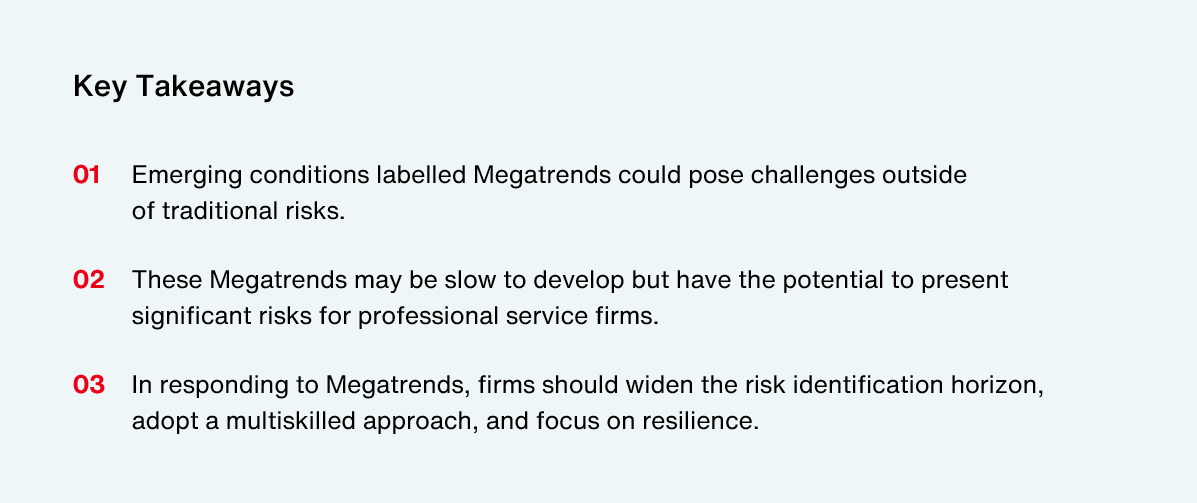The Professional Services Practice at Aon’s Keith Tracey discusses the Aon 2024 Client Trends Report, its relevance to professional service firms and some possible responses.

We have previously written about the Polycrisis and commented on the risks identified in Aon’s Global Risk Management Survey. Both Insights make clear that uncertainty is increasingly part of the risk landscape for professional service firms.
Why do such conditions of uncertainty exist? Are there larger factors at play? Are we experiencing trends that are creating emerging risks and increasing the threats from traditional risks? Some would argue, yes, and that this uncertainty is due to Megathreats or Megatrends.
Aon has published a report on Megatrends. The report covers a broad horizon of business sectors. Megatrends carry big challenges that overlap in scope with risk. We will examine that relationship.
What is a Megatrend?
Megatrends are macro political, economic, or social factors representing a major movement, pattern or trend. They may be emerging and are likely to have significant impact on the business environment. They are potentially slow moving and pose medium term threats but can have consequences in the short term. They tend to be interrelated with the prospect for cumulative consequences.
The term Megatrends originated with
John Naisbitt’s “Megatrends: Ten New Directions Transforming Our Lives” published in 1982. The trends identified then covered society, the economy, and politics. One trend that he successfully identified was the coming of the Information Age. Some of the others proved to be correct, some only partially so, while others did not manifest themselves. That is the fragility of predicting the future.
It is perhaps a feature of some commentary from that time and subsequently that the trends were seen as positive and largely optimistic. It seems that today’s predictions are more guarded or even, perhaps, pessimistic. Conflicts in various forms, the environment, and the world economy are currently areas of major concern, and of course cyber risk have emerged as a major threat since the book appeared.
Aon’s Report identifies Four Megatrends

Megatrends and Risks
How relevant are these trends to a Professional Service Firms’ (PSF’s) risk management strategy?
Are they to be found in the recently published Aon GRMS PSF risk survey?

These risks may manifest themselves as direct threats to professional firms, or indirectly as these trends affect clients. Of course, interrelationships exist and there is the potential for convergence.
Other commentaries have mentioned macro threats that fall outside of these Megatrends. Commonly appearing are the debt crisis, demographics, inequality, and migration: all issues that require cooperation to address. Sometimes alternative terms, such as “the end of globalization”, are used. One consistent theme is the conflicts happening between nations, manifested in cyber-attacks, trade wars and sanctions, and other forms.
As to responses, time horizons are important and may be a source of inertia. To illustrate, the threats of climate change present medium to long-term issues and there may currently be an insufficient response. Cooperation is vital, which adds an additional barrier to action. The current threat is nonetheless real and encompasses many risk considerations, not least for the insurance industry, and in the ESG realm.
Looking back to Naisbitt’s book, the optimism of the 1980s appears to have disappeared. Naisbitt talked about a more inclusive society and predicted that other trends would address some of the big threats.
How can professional service firms respond to these conditions today?
The Response
In our discussion of responses to the risks in the Aon survey,
we offered several practical suggestions. These included a widening of the risk identification horizon, a multiskilled approach, and a focus on resilience.
Some additional thoughts when considering responses to the potential influence of these Megatrends are:
- These are large movements by definition. Strategic issues require a holistic risk assessment, and employment of systems thinking techniques.
- Many of the threats fall outside of an organization’s control and go beyond building resilience into the realm of future strategy.
- Complacency should be avoided even if no short-term threat appears to exist.
- Interconnected and exponential effects are possible and could be devasting. The conventional approach to risk identification and treatment may be too linear.
The Professional Services Practice at Aon values your feedback. If you have any comments or questions, please contact Keith Tracey.
This article is adapted from Megatrends and Risk – How to Navigate the Impacts (June 2024) from the Professional Services Practice at Aon.